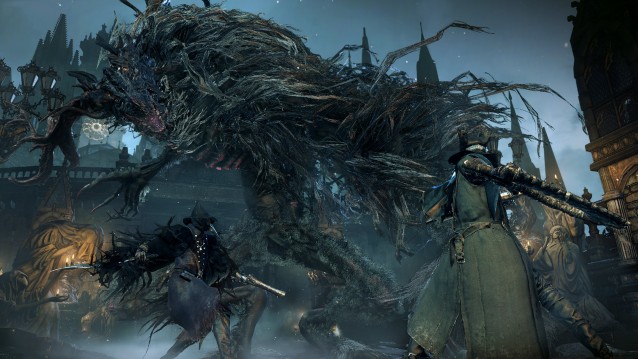From Software are famous for their extremely hard games, and from Demon’s Souls to Dark Souls to Dark Souls II, you know you’re not going to have an easy time of this developer’s games. And like button-mashing masochists, everyone keeps going back for more punishment. Myself included. And this brutality is why we’re going to review Bloodborne, From Software’s first PS4 outing.
You’re going to hear the phrase “like Dark Souls, but…” a number of times in this review. This is just a heads up in case anyone gets tired of the phrase. So the first one starts here: Bloodborne is like Dark Souls, but set in a Victorian London-esque city of Yharnam. Your character, or characterette if you so choose, has the wonderful task of seeking out a cure to their afflictions, and this is the reason you’ve journeyed here. Except that Yharnam is in the middle of its own problem epidemic that turns normal, agreeable people into horrific monsters. I believe that the term “Eldritch” is properly applied here, since the game’s lore smacks of Lovecraftian influences. Other terms you could use would be “grotesque”, or perhaps, “NopeNopeNope”. The enemies here are the stuff of nightmares, so if body horror freaks you out, you’re better off playing something else. The story itself is pretty nuts, and takes a lot of digging around to properly uncover, too. Much of the story and background is hidden within the folds of descriptions in the various items and so on that you find. Be prepared for a lot of reading if you like to understand what you’re playing.
So how DOES it play? Like Dark Souls, but more nimble. Your player character is well agile, able to move around the battlefield with quite some alacrity. This wouldn’t be problem if not for the fact that everything else is ALSO damned nimble. You need to treat all your attacks as hit-and-run. The game gives you two kinds of weapon: your standard “Like Dark Souls, but…” martial weapon (that’s “big, sharp blade thing” to you unlettered readers), and a gun of sorts. The big, sharp, blade thing also has two forms that you can switch between, and these two forms fulfil different purposes in combat. For example, one weapon’s form is good for getting all up in the face of an ugly horror attacking you, while its other form is good for dealing with masses of uglies at once. The gun is useful for getting the attention of horrors and little else, since it doesn’t do much damage. And “Like Dark Souls”, enemies drop “blood echoes”, analogous to Dark Souls’ souls. And also “like Dark Souls”, when you die, you drop said blood echoes, which you can trek back to retrieve. In fact, so much of the game is like Dark Souls that you have to start asking “What part of it is NOT like Dark Souls?”

The answer may be a little surprising: the difficulty. Bloodborne is actually easier than Souls, for various reasons. Not by a hell of a lot, mind, but still easier. Your character’s nimbleness makes a big difference here, and you’ll find that the “stand your ground and attack” techniques that work so well in the Souls games are far less acceptable here. Standing your ground will get you ground into hamburger mince. Furthermore, your nimbleness can help you a hell of lot: if you manage to counter-attack an enemy quickly enough after an attack, you’ll recover some health.
Another difference is something called the Chalice Dungeons, which are procedurally generated dungeons that you can fight through for great reward. To my mind, this was one of the best parts of the game; I love procedurally generated dungeons, and the ability to play through completely new areas each time was a great way to build up my character’s abilities and hone my own skills at the same time.
There is a multiplayer component to Bloodborne, so “like Dark Souls” there are three kinds of multiplayer. The first type, co-op, allows you to summon other players into your game to help you with difficult fights. The second type, PvP, allows you to go about fighting with others, you filthy misanthrope. This works much the way it did in the Souls games, so if you’re familiar with game invasions, you’ll be right at home. The third one, “Like Dark Souls”, is the game’s way of letting you leave messages and warnings and the ghosts of how you were defeated. In Bloodborne, your deaths are left as cute little tombstones that you interact with. The notes, also with a cutesy overtone, have little skeletons dancing around them. I personally don’t see why the added graphical morbidity was needed, but evidently some people needed to be reminded that “someone died here, you heartless bell-end”.
Graphically, the game is gorgeously moody. The PS4 provides a beautiful moodiness to Yharnam that’s utterly engrossing. It’s not as linear as the other games, and Yharnam provides a delightfully sprawling environment for you to explore. And die in. And you’ll be doing that a lot. And this is where we hit the game’s worst aspect: loading times. Dying a lot means loading a lot, so you’ll be seeing that damned loading screen a heck of a lot.
Look, to be honest, if you enjoy the torture of From Software’s games, you’ll already have a copy of Bloodborne. If you don’t enjoy action hack-n-slash RPG games, you’ll probably already be playing something like Battlefield instead. But if you’re playing something else, you’re missing out on possibly one of the best games the PS4 has to offer.
Final Score: 9 Brutally Difficult Prawns out of 10
Detailed Information
Developer: From Software
Publisher: Sony Computer Entertainment
Distributor: Ster-Kinekor
Age Rating: 16
RRP: R799
Website: https://www.playstation.com/en-us/games/bloodborne-ps4/





